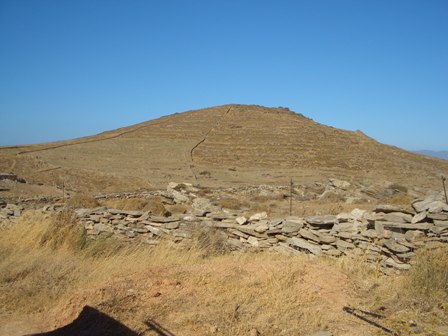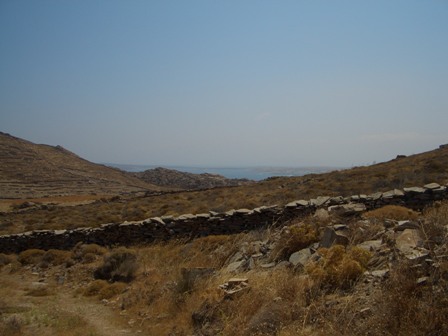Cultural Landscapes
Cultural landscapes reflects a special type of interaction of mankind with nature. It alters the landscape and consequently becomes over time an inherent characteristic of the area e.g. on Greek islands the terrace like small plots of land used by farmers in the past or else the walls running up the mountain to delineate the land and to keep the animals inside.
Stone walls on Paros: abandoned landscape
World Archaeological Congress
There took place 11-16 April 2005 a conference about "Cultural Landscapes in the 21st Century".
Organised by the Forum UNESCO - University and Heritage 10th International Seminar, it was connected to the International Centre for Cultural and Heritage Studies (ICCHS) at the University of Newcastle upon Tyne, UK.
This conference looked at landscapes in all of their possible manifestations and wanted to explore above all possible divisions between cultural and natural landscapes and question at the same time the value of this division.
Contact:
T +44 (0)191 222 7419
F +44 (0)191 222 5564
W www.ncl.ac.uk/unescolandscapes
The conference had the following seven themes which can be used to enter discussions and reflections as to what is happening to cultural landscapes. There is a need to establish some base line in reference to the term "cultural landscapes" in order to adjust planning, planning laws and systems in accordance with this specific sphere of interaction by man with nature.
1. Cultural Landscapes, Museums and Heritage (Tangible and Intangible)
- Memory and place
- Food and cultural landscapes
- Music and place
- Dance and place
- Spiritual/religious landscapes
- Indigenous landscapes
- Language and place
- Ecomuseums and cultural landscapes
- Museums and cultural landscapes
- Heritage sites and cultural landscapes
- Archaeological heritage as cultural landscape
- Natural Heritage and cultural landscapes
2. Cultural Landscapes and Visual Culture
- Art galleries/art museums and their place in the cultural landscape
- Artists and their relationship to specific locales
- Landscape as art (e.g. gardens)
- ‘Land art’
- Permanent and temporary art interventions in the landscape
- Public art in the landscape
- Art galleries and regional/national identities
- Rock art and cultural landscapes
- Cultural landscapes and Virtual Reality
3. Cultural Landscapes, Identities, and Communities
- Landscape as a part of international, national, regional, or local identity
- Cultural landscapes and cultural diversity
- Exclusion from cultural landscapes
- Public participation in landscapes
- Sustainable communities and cultural landscapes
- Conflicting uses of cultural landscapes
- Diaspora and migration within or across cultural landscapes
- Exile and concepts of “home” – taking cultural landscape with you while leaving the geographical one behind
- Place as intersection of different identities
- Inventing new cultural landscapes and alternative conceptions of place
4. Cultural Landscapes, Tourism, and Economics
- Landscapes as economic resource
- Sustainability and landscapes
- Ethics of using cultural landscapes
- Balancing demands by tourists and locals upon cultural landscapes
- Tourism as a means of regeneration for the landscape
- Reinventing post-industrial landscapes as heritage landscapes
- Heritage industry and cultural landscapes
- Entertainment sector and its impact on cultural landscapes
5. Cultural Landscapes and Architecture
- Cityscapes as cultural landscapes
- Coastal landscapes
- Rural landscapes
- Signature buildings and cultural landscapes
- The politics of listing architectural and landscape heritage
- Managing historic buildings and landscapes
- Managing historic buildings
- Architecture and historic landscapes
- Vernacular architecture and cultural landscapes
- The designed landscape as cultural heritage
6. Cultural Landscapes and Education
- Learning through cultural landscapes
- Teaching cultural landscapes
- Informal and formal learning systems and cultural landscapes
- Lifelong learning and cultural landscapes
- National curricula and cultural landscapes
- Working with UNESCO World Heritage Education Project
7. Cultural Landscapes, Management and Protection
- Funding cultural landscapes
- Management plans/strategies for protecting cultural landscapes
- Legislation and conventions (regional, national, and international)
- Ethics and cultural landscapes
- Governments and Cultural Landscapes
- NGOs, International bodies and Cultural landscapes
- Charities and the management/protection of cultural landscapes
- Communities and their role in managing or protecting cultural landscapes
- Managing conflicting interests/demands upon cultural landscapes
- Issues of ownership, control, and legal/ethical rights
Source:
http://conferences.ncl.ac.uk/unescolandscapes/english/themes.php
« Rescue of House in Exarchia | Melina Mercouri International Prize for Cultural Landscapes (UNESCO-Greece) »


